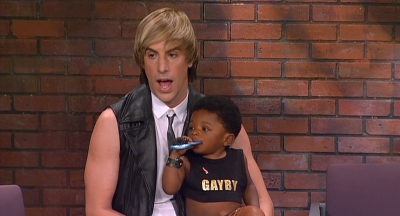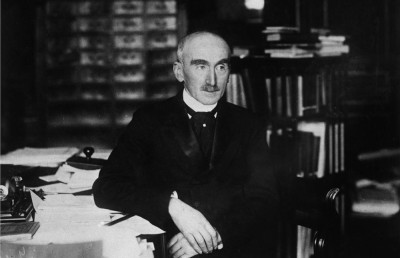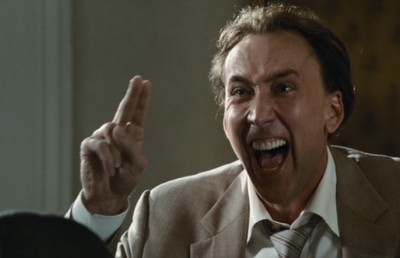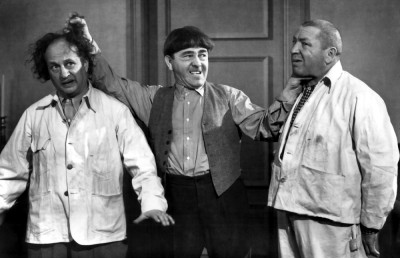Now Playing in an America Near You: The National Threat of Sacha Baron Cohen
Laughing at Whom?

No doubt to Sacha Baron Cohen’s delight, and certainly to his investors’, the twin mockumentaries Borat (2006) and Brüno (2009) have far outshone his initial foray into world cinema, the dismally overblown Ali G Indahouse (2002). Exploiting a simpler production design and execution, these later projects, modeled on the American road movie but with little respect for America in general, made economic use of the perennial weirdness of life stateside; its mind, matter, and media. [1] Between the two “B” movies, both directed by Larry Charles, Borat is the better behaved, the more endearing. Brüno is somewhat harsher in spirit if finer in appearance, and to its credit it has generated just as much talk as its older brother, particularly about the political missteps and/or validity of it’s central creation: a spectacularly gay, global village idiot. In the flurry (not firestorm) of controversy that attended Brüno, questions were repeatedly raised as to whether the socio-sexual curiosities the film lampoons, sometimes by merely lensing, are worthy targets for a comedian of Baron Cohen’s caliber. Brüno is apparently somewhat harder for us (i.e. Americans) to embrace than Borat, though the reason is hard to put our collective finger on. At the very least, the wide ranging, sometimes extreme response to Brüno is indicative of a rich conflict of positions between members of the viewing public –a vast and perhaps undefinable group of individuals who cannot help but be concerned with things American, without necessarily being American. The reception Brüno received here in the States (i.e. curiosity followed by cold shoulder) also demonstrates a more fundamental conflict for anyone who seeks and submits to comedy’s double-edged sword. We want to laugh, but not be hurt in the process, in spite of our so often being the butt of the joke. The very fact that the natural response to good (if not “proper”) comedy is a kind of spasmodic joy would seem to suggest the risk is worthwhile, because this joy is so clearly an improvement over the stasis, boredom, hatred, confusion, or whatever other state that divides the laughing individual from their former self. The most cruel of comedy can appear redeemed by a light and seemingly automatic reaction. The trouble comes in the aftermath; in the attempt, however careful and learned, to justify the event of comedy in question, stimulus and all. Freud himself was prone to the Quixotic task of laying bare the psychology of laughter, with page after page of earnest theorization in defiance of the age-old axiom that to explain a joke is to kill it. Picture for a moment an earnest reader’s sudden outburst of laughter at The Joke and Its Relation to the Unconscious (1905). It’s not a difficult image to conjure. Now imagine that this reader laughs not because of one of the book’s many examples, but out of a purely contradictory response, transforming the whole scholarly enterprise into a form of protracted, dry comedy. The author may well have defended such a response as dynamic rather than disrespectful, noting, perhaps, that the mind in conflict with itself or its environment produces not only self-deception and pathology, but also innovation, self-awareness, and growth.

The spate of discomfort-exploiting/inducing humorists in recent years (e.g. Sarah Silverman, Larry David, Sacha Baron Cohen), appear to be a vanguard not only of new American comedy but of a tougher regard for humor in post 9-11 entertainment. [2] As much as we Americans yearn to breathe free with the release of laughter, this basic impulse –one might argue inalienable right– must contend with a new coolness born of the perceived threat of farce, ribaldry, artful ribbing, or any other light handling of things firmly held (the most precious of which are naturally one’s own). [3] The protracted pain of Arab-Israeli relations is one widely grasped, and lived, phenomenon. So is homophobia and its various shades. America’s cult of youth, idol-making, and pathological diet are other things we, as Americans, are often too mired in to step back and poke fun at. The ostensibly clueless Brüno and co. are only too willing to help us in this regard. In spite of Brüno being the most outrageous, most shrill of Baron Cohen’s characters, the burden of comic infelicities is clearly shared by his targets. Arguments of queer minstrelsy aside, Baron Cohen’s innocent abroad gets a good deal of mileage from uniquely American phenomena (e.g. a Springeresque talk show, Christian fundamentalists bent on straightening their gay brothers, a Southern swingers’ party with zero patience for Brüno??’s kibitzing). The results may not always be funny, but the value of “cultural learnings of America for make benefit” remains. These are our flavors of parochialism, our lifestyles and deep convictions. To see them afresh through foreign eyes may indeed be welcome, if we wish to see them at all. Is there a similar value, we might ask, in Baron Cohen’s leveraging laughs with borderless phenomena, such as homosexuality? (Not to mention genocide, vanity, hypocrisy, prudery, and an insidiously global media.) Critics like A. O. Scott do more than ask the question. [4] They tell us, the audience, that to caricature gay men as Baron Cohen does reflects and reinforces some of the most unfortunate and even dangerous elements of pop culture. This culture is straight, and comedy about gay sex, or love, when clownishly portrayed, draws unwholesome energy from fear, from the widely held notion that “sex between men is inherently weird.” Scott has a point, but consider his example of the early set piece between ??Brüno and his lover, depicted as an absurdly athletic sexual circus. The idea of viewers regarding a similarly staged heterosexual scene as merely “inventive” is laughable in itself. I would argue that the scene referred to functions like most of Baron Cohen’s comedy, deriving humor from pushing firmly, repeatedly, against limitations of all sorts (of size, gravity, religious intolerance, household objects, the proper use of immigrant labor, etc.). Need I add that the staging and broadcast of such scenes do not merely indulge the phobic, but push against a dearth of homosexual imagery elsewhere?

A central question Scott and others have raised (and gingerly answered) is whether Brüno should be considered “bad comedy.” It’s true the film might reward firmly held stereotypes, contributing to the oppression of homosexuals generally. The risk of its grotesque image is there, but the spirit of its gags is, I think, more an expression of liberty than hostile intent. To be clear, Baron Cohen is no Lubitsch, but he has something of Lubitsch’s liberality in his range of targets. This group is much broader than the Southern “fish in a barrel” Baron Cohen is accused of larding the film with. Yes, the humor is often profoundly disrespectful and acidic, but it is also omnidirectional, taking on multiple regions of the US –in effect, multiple Americas– and it is almost invariably concerned with provocation; of laughter, in particular, more than the progress or pollution of the viewer, or the ruin of his subjects (did the Alabamans of the ‘redneck’ hunting party come off badly? Was the comic dimension of the campfire segment diminished by the hunters’ reticence?). Maybe it’s only natural, then, that a portion of Brüno’s audience, the unamused portion, so often grouse about the “authenticity” of the pranks, or whether the strong reaction Baron Cohen gets, in the box office or the back row, is really evidence that “the joke is on you.” For the American viewer the joke is very likely on you, to some extent. Whether you should find it funny is another matter.

The simplest measure of bad comedy is its failure to elicit laughter, and Brüno??’s weak earnings domestically to some extent reflect the conflation of light entertainment and notions of propriety, or what consumers and critics consider legitimate targets for satire. [5] But the laugh response is prone to individual taste, and it can be faked. In his review of ??Brüno for The New Yorker magazine, Anthony Lane questioned the genuine amusement of several women, sitting near him in the theater, during the talking penis bit. [6] Lane’s discounting of the women’s response as merely “nervous” exploited the fact that laughter is sometimes performed by audience members, typically when faced with highly contentious material. However, I very much doubt Brüno is purely a product of trend, or that its comic virtue –if any– is dependent on social pressure to respond to the film favorably. Clearly, anxiety is an important element of Baron Cohen’s caricature, but at what point do the viewer’s laugh pains cease to be about “good” comedy and become symptomatic of some social ill, an ill worsened, not leavened, by laughter?
The dangers of derogatory art are notoriously difficult to assess, and a definitive list of what should or should not be funny may be the only enduring joke. Comedy will always be problematic in its easy regard of individuals and issues of genuine suffering, in part because its ultimately positive effect, glimpsed more in humored response than edification, will remain elusive. I wouldn’t argue with the many individuals who have walked out of Brüno. Nor would I say Baron Cohen’s art is the sharpest or broadest in the catalogue, but now that he has officially retired his trio of characters we can see the full course of his comic invention through them. They were sufficiently convincing in their hybrid personages to help Baron Cohen tilt at the tower of high fashion, saintly celebrity adoptions, larger-than-life figures (political, intellectual, financial, athletic, etc.), media-manufactured identity, the American military, conservatism, liberalism, carbo-phobia, and a plethora of ethnic and racial untouchables. Sometimes Baron Cohen’s barbs were on the mark, sometimes not, but the man can’t be faulted for ambition. He certainly can’t be faulted for his success as a clown, one to whom the interview and documentary form served as a vehicle for his humor, not an instrument for advancing intolerance.

Endnotes
1 Considering Sacha Baron Cohen’s foray into the American, and thus international, feature film market, his successful return to a scaled-back format akin to his early work on BBC 4’s The 11 O’Clock Show suggests his comedy benefits from a larger screen only superficially. The fact that television veterans directed all three of Baron Cohen’s features underscores this aspect of the work. It is also worth noting the latter two films’ conceptualism —i.e. their distance from the spectacle of Ali G Indahouse and similar star vehicles— and the way they anticipate, though perhaps not consciously, the changing face of film consumption as it fractures into ever smaller screens and durations. This is a global, internet-driven trend that Hollywood and its domestic audience is hedging its bets on, as indicated by the success of long form, raunchy-yet-sentimental comedies by Judd Apatow, et al. Crossovers such as Borat are part of a much larger movement toward digital imaging, style, and projection in cinema. The location of this movement is the industrialized nation, and it puts the public of public screening somewhat at odds with technologies and material more readily associated with private viewing. Brüno and Borat are just two of the insurgents in this shift, insofar as they demonstrate an anti-Hollywood stance that eschews lavish design and set work, film formats, and the celebrity system —except for the purpose of lampooning. In addition, even when paired with prominent, media-savvy figures, Baron Cohen has had to perform anonymously, concealing himself beneath relatively unknown personages in order for many of his set-ups to be effective.
2 The long shadow of American culture is virtually inescapable, made up as it is of threat and seduction. This is perhaps easier to glimpse in economic terms than policy. The global entertainment and media market is dominated by the US in revenue and expenditures (for material seen throughout the world, whether through legitimate channels or by piracy), while the US is responsible for nearly half of the world’s military spending. Though US feature film production in 2002 was considerably less than that of Europe (with the US contributing 543 features, the EU 884, and India approximately 1200) the vast influence of American film, television, music and related media outweighs any particular product or series of products that originate in the States. Figures from “Global Film Production and Distribution: New Records for Investment and European Output,” Screen Digest. July 1st, 2003.
3 Paradoxically, this conflict increases what Freud might describe as the power of the joker to strip their target, while shifting the aim of their veiled hostility to the listener/viewer.
4 “Teutonic Fashion Plate Flaunts His Umlauts,” The New York Times, July 10th, 2009.
5 Outside of the US, Brüno grossed $70,733,713 in ticket sales, while domestically it took in only $60 million, for a difference in earnings of over $10 million. In contrast, Borat grossed well over $128 million domestically, but had a foreign ticket sale difference of only $4.5 million (international gross being $133,066,786). When we consider the performance of the two films worldwide, the difference in gross ticket sales is a staggering $130,784,551, Brüno being the weakling. The reasons behind these discrepancies are unclear, but they are tempting to speculate on, especially when we consider the similarity of the two films; the fact that both were shot on HD, were written by, starred, and directed by the same individuals, used similar interview and voiceover strategies, exploited unwitting participants, were both set in the US and followed a similar narrative centered on an awkwardly foreign anti-hero. Earnings information from The Numbers Box Office Data.
6 The scene in question contains something rather foreign to American cinema: full (or focused) frontal male nudity. The humor of this image hinges on the fact that what we see is not the phallus as symbol of power, but an animated cartoon of maleness, aesthetically and culturally impotent. To drive home this characterization, the image is presented in the context of a preview audience, staring in disbelief as they attempt to assess the marketability and overall quality of the footage. Among other things, we see Brüno accosting a celebrity, who yells at him to fuck-off. That the star is caught on camera is apparently reason enough to include the brief moment in the promo, in spite of the negative response Brüno’s pursuit elicits (and it’s no accident he is pursuing the very straight Harrison Ford, known most recently for a series of national/domestic defense thrillers). Whether the test group and their responses are genuine, or as phony as the promo video, seems to me beside the point. With its various elements, the scene contains a sufficient realism to achieve the surreal. Anthony Lane describes it differently: “…the two young women beside me howled at the talking penis (not a bad emblem of the average male, they would say), and, if I had tried to explain that the Marx Brothers—sowers of extreme sedition, like Baron Cohen—sustained an entire career of ignobility without displaying a single erection, they would not have believed me. Even so, there was something forced in the women’s laughter, as if they wanted to banish any suspicion of prudery, and to prove themselves far too cool for disgust.” From Lane’s review, “Mein Camp,” The New Yorker, July 20th, 2009














